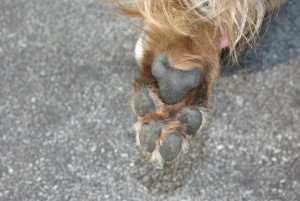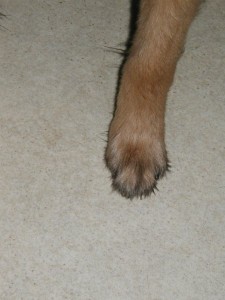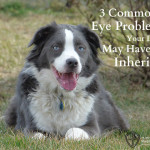Paw Power
There is a saying among horsemen that “no hoof, no horse”. For shepherds, you could say about herding dogs, “no paw, no dog”. That may seem a bit dramatic, but if you want a dog truly capable of doing the work his breed was developed for, you need correct foot conformation.
Ideal conformation will vary from breed to breed. To a certain extent, the foot conformation reflects the area the breed was developed in and the type of herding work the dogs were expected to do. Each herding breed has a breed standard. This is basically a blueprint of the ideal conformation for that breed. The breed standard was developed with the original function of that breed in mind.
Herding dogs need to be able to move. They may have to sprint at times, leap over or through gates and fences or do long runs. The dogs who were drovers need to be able to do a working trot for hours. The breed standards for herding dogs all address correct foot conformation with that work in mind. You can find the standard for your breed by searching the AKC website, or looking at the parent club site for your breed.
The three breeds I have worked with most often are the Belgian Tervuren, the Pembroke Welsh Corgi and the Australian Shepherd. The Corgi standard describes the ideal foot as oval with the two center toes slightly longer than the other two. Pads are to be strong and the feet arched – not splayed. For Belgian Tervurens, there is a slight difference between front and hind feet. Front feet are to be round, “cat footed” with the toes curved and close together – a tight knit foot. Hind feet can be slightly elongated. In both cases, the pads should be heavy and the nails strong. The ideal Aussie foot has an oval shape, but compact with tight, arched toes. Pads are again addressed – thick and resilient is the ideal.
Do all those minor details really matter? Well, yes, they do. Every herding breed standard addresses feet. All three breeds mentioned here suggest a “tight” foot without any sign of splaying. With a tight foot and strong nails, the dog can dig in for a quick turn or a burst of speed if needed. Think about that yearling calf or young lamb who suddenly tries to bolt. Your dog needs to be able to get right on that.
Nails
Strong nails are important because you don’t want a dog laid up from work by broken or torn nails. You have some responsibilities here. Genetics and conformation can only do so much for nails. You need to keep nails trimmed (though I find with correct shaped feet, I do much less in the way of nail trimming). You also need to provide adequate nutrition. Dogs need a balanced diet for the nutrients required for healthy nails. Biotin, zinc and fish oil (as a source of omega fatty acids) are all important for healthy nails. Plain gelatin can also be beneficial for dogs with chronically brittle nails. Discuss any supplements with your veterinarian before adding them so you don’t overdo any vitamins or minerals. Too much can be as bad as, or worse, than too little.
Pads
Next up are tough pads. Your dog’s lifestyle will influence his pads a bit. If you live where the climate is humid or wet, your dog’s pads may naturally be a bit soft, especially if he primarily walks on grass. Dogs who live on shale type ground, sandy terrain or walk on asphalt or cement daily will have tougher pads. You can also purchase topical ointments to help toughen up your dog’s pads. In some cases, you might end up walking your dog in booties, but clearly that is not the ideal.
When a dog goes acutely lame, the foot is where I look first. A broken or cracked nail (so the sensitive “quick” is exposed) can be extremely painful. The same goes for a worn off pad exposing the sensitive tissues underneath. A broken or dislocated toe will also cause three legged lameness.

So what can you do? If the nail is broken but hanging, be tough and simply snip or yank it off. If you leave it, your dog will have pain every time he steps on that foot. Yes, the exposed quick will be painful but it will heal quickly without the ragged nail irritating it. If the nail is basically intact but cracked, you can try some super glue on the crack after soaking the paw to clean it thoroughly.
A worn off pad will also toughen up fairly quickly with time. When the sensitive pad tissues are exposed a coating of liquid bandage can make your dog much more comfortable.
Broken and Dislocated Toes
For broken or dislocated toes, your veterinarian may set your dog up with a “spoon splint”. This type of splint has a spoon type end where your dog’s paw sits. The back of the splint runs up your dog’s leg. This stabilizes the paw and minimizes the motion of the toes. Healing is often faster with a splint on. Surgery is generally avoided as toes don’t have a lot of bone or circulation to help with healing. Amputation is generally not a problem for most dogs even though we humans tend to cringe at the thought of it.
Footing
If you are raising puppies, try to provide a variety of footing options. It is good for puppies to master slick footing like linoleum but ideally they should be on gravel, grass or other textured types of footing to encourage tight feet most of the time. You can’t totally tighten up genetically splayed feet with footing but you can mess up genetically good feet with poor footing.

Does all this foot/pad stuff really matter? I can give you a real life example. I was trialing with my two Belgian Tervurens during a drought at a farm basically set on a shale ledge. At the end of the weekend, my male Terv, who had incredibly tight, catlike feet, was fine. His pads showed a bit of wear (some of the rough appearance of the pads were smoothed off, but no sensitive areas exposed) but he was totally sound. My female Terv had slightly long feet in front. By the end of the weekend, she had worn the pads on all four feet down to sensitive tissue. She was fine going in for her last run, but finished the run, came out and lay down. I thought she might have heat stroke but she was breathing fine, etc. She had just worn the pads through on that run and her feet literally hurt too much without the stimulation of working her stock to want to walk.
Most herding organizations will allow dogs to run in booties but the judge must inspect the feet before your run. If your dog already has worn pads, they will not allow your dog to run.
When you look for your next herding prospect, start from the ground up. You want good feet!
Article By:
Deb Eldredge, DVM






